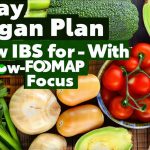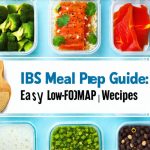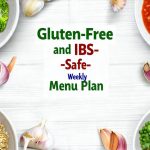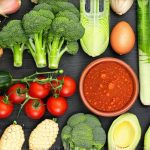Navigating dietary restrictions can feel like charting unfamiliar territory, especially when multiple sensitivities are involved. Many individuals experience digestive distress – including nausea – alongside Irritable Bowel Syndrome (IBS) symptoms or other gastrointestinal conditions that necessitate a low-FODMAP diet. Combining these needs with a plant-based lifestyle adds another layer of complexity. It’s entirely possible, though, to create delicious and nourishing meals that address all three concerns: plant-based nutrition, reduced FODMAP content, and minimized nausea triggers. This requires understanding the underlying principles of each approach and applying strategic food choices and preparation techniques. We’ll explore how to build a fulfilling diet without sacrificing flavor or nutritional value.
This article aims to provide practical guidance for designing meals that are both gentle on the digestive system and aligned with plant-based ethics. It’s not about restriction; it’s about informed substitution and creative cooking. Understanding why certain foods cause problems is key, as is learning how to modify recipes or find alternatives that better suit individual tolerances. We will focus on building blocks – core ingredients and culinary approaches – that empower you to create a diverse range of plant-based, low-FODMAP, anti-nausea meals tailored to your specific needs and preferences. Remember, everyone’s tolerance levels differ, so personalized experimentation is often necessary. You can learn more about preparing and seasoning meals to minimize digestive upset.
Understanding the Interplay: Low-FODMAP, Plant-Based & Anti-Nausea
The core principle of a low-FODMAP diet lies in reducing fermentable carbohydrates – sugars that are poorly absorbed in the small intestine and then fermented by bacteria in the large intestine, leading to gas, bloating, pain, and other IBS symptoms. FODMAP stands for Fermentable Oligosaccharides, Disaccharides, Monosaccharides And Polyols. These include fructose (in excess of glucose), lactose, fructans, galactans, and polyols like sorbitol and mannitol. Many plant-based staples – such as onions, garlic, apples, and beans – are high in FODMAPs, necessitating careful selection and portion control. A fully plant-based diet, by definition, excludes all animal products, which can sometimes simplify things (dairy is a significant lactose source) but also requires mindful attention to protein sources and nutrient adequacy. If you struggle with bloating or discomfort after meals, consider how to plan balanced options.
The anti-nausea component adds another dimension. Nausea isn’t always caused by food itself; it can stem from strong smells, textures, or even the thought of eating. Simple foods are often better tolerated when nauseous – bland flavors, easily digestible ingredients, and minimal fat content are key. Strong spices, overly processed foods, and heavy meals should generally be avoided. Combining these three considerations requires a nuanced approach to meal planning. It means prioritizing low-FODMAP plant proteins like tofu and tempeh (in moderation), focusing on tolerated vegetables (carrots, spinach, zucchini), and utilizing gentle cooking methods that preserve nutritional value without exacerbating nausea. For those dealing with late night meals, managing acid buildup can be helpful.
Many people find that specific plant-based foods aggravate their nausea. This could be due to the texture (e.g., fibrous vegetables if digestion is slow), strong flavors, or even individual sensitivities beyond FODMAPs. Keeping a food diary can be incredibly helpful in identifying personal triggers. The goal isn’t necessarily to eliminate entire food groups but rather to understand your body’s response and adjust accordingly. For example, someone might tolerate small amounts of spinach but not large salads.
Building Blocks for Plant-Based Low-FODMAP Meals
The foundation of a successful diet lies in understanding the safe options. When building plant-based low-FODMAP meals, it’s crucial to know which ingredients can be reliably incorporated and how to modify or substitute high-FODMAP alternatives. For protein, tempeh (in moderate portions) and firm/extra-firm tofu are excellent choices. While legumes generally fall into the higher FODMAP category, canned lentils (rinsed thoroughly) in small quantities (around ¼ cup) can be tolerated by some individuals. Rice and quinoa are safe grain options. If you’re on the go, consider portable snacks that fit your needs.
Vegetables offer a wide range of nutrients but require careful selection. Low-FODMAP vegetables include carrots, spinach, kale (in moderation), zucchini, bell peppers (red and yellow are generally better tolerated than green), cucumbers, and eggplant. Fruits can be more challenging; blueberries, strawberries, oranges, and grapes are often well-tolerated in moderate portions. Avoid apples, pears, mangoes, and stone fruits like peaches and plums as these contain higher levels of fructose.
Flavor is essential! Since garlic and onion are high-FODMAP, alternatives are needed. Infused oils (garlic infused oil removed before use – the flavor remains but the FODMAPs do not) can provide a similar aromatic profile. Ginger, turmeric, and herbs like basil, thyme, rosemary, and chives are safe options for seasoning. Lemon juice and vinegar add brightness without triggering symptoms. Consider using asafoetida (hing) in very small amounts as a substitute for onion/garlic flavor – it has a strong smell but mellows during cooking.
Navigating Protein Sources & Portion Control
Protein is vital, even on a restricted diet. Tofu and tempeh are versatile options that can be incorporated into countless dishes. However, portion size matters. Start with smaller amounts (e.g., 85-100 grams of tofu) to assess tolerance. Marinating tofu in low-FODMAP seasonings before cooking adds flavor and improves texture. Tempeh, while slightly higher in FODMAPs than tofu, can be a good option for those who tolerate it well.
Beyond tofu and tempeh, consider incorporating small amounts of canned chickpeas (rinsed very well) or red lentils if tolerated. These provide valuable fiber and nutrients but should be consumed cautiously due to their FODMAP content. Remember that thorough rinsing significantly reduces the FODMAP load in legumes. It’s also important to pair these protein sources with low-FODMAP carbohydrates and healthy fats for balanced nutrition.
Gentle Cooking Methods & Food Preparation
How you prepare your food can greatly impact its digestibility, particularly when nausea is a concern. Steaming, poaching, baking, and gentle sautéing are preferred methods over frying or grilling which often involves more fat. Avoid overly processed foods as these may contain hidden ingredients that trigger symptoms.
When preparing vegetables, consider peeling them to reduce fiber content if needed – this can make them easier to digest. Cooking vegetables until they’re tender-crisp rather than completely soft also helps with digestion. Chewing food thoroughly is crucial for breaking down carbohydrates and proteins, reducing the strain on your digestive system. Hydration is also key; drinking water throughout the day aids in digestion and prevents constipation. Improving posture can also assist with digestive comfort.
Addressing Nausea Triggers During Mealtime
Nausea can be debilitating, so creating a comfortable eating environment is essential. Avoid strong smells – open windows or use an air purifier if necessary. Choose bland flavors over spicy or overly seasoned foods. Small, frequent meals are often better tolerated than large ones.
Focus on textures that you find appealing; some people prefer smooth purees while others do best with slightly textured foods. Avoid greasy or fatty foods as these can exacerbate nausea. Ginger is a well-known anti-nausea remedy – incorporate it into your meals as tea, grated fresh ginger in cooking, or crystallized ginger (in moderation). Finally, listen to your body; if you feel nauseous while eating, stop and rest. Don’t force yourself to finish a meal. Managing acid buildup may also help reduce nausea. And for sustained relief, consider exploring low-acid diet plans.
This information is for general knowledge and informational purposes only, and does not constitute medical advice. It is essential to consult with a qualified healthcare professional for any health concerns or before making any decisions related to your health or treatment. Preparing and seasoning thoughtfully can also make a significant difference.


















